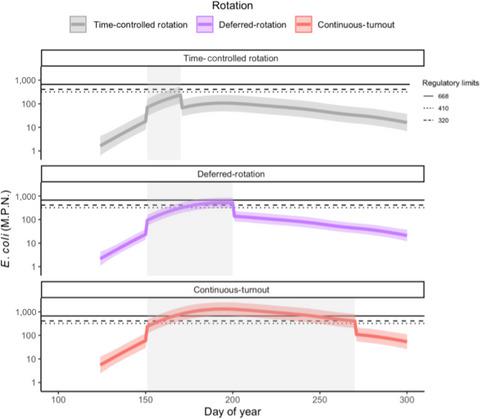当前位置:
X-MOL 学术
›
J. Appl. Ecol.
›
论文详情
Our official English website, www.x-mol.net, welcomes your
feedback! (Note: you will need to create a separate account there.)
Rotational grazing can mitigate ecosystem service trade-offs between livestock production and water quality in semi-arid rangelands
Journal of Applied Ecology ( IF 5.0 ) Pub Date : 2021-06-23 , DOI: 10.1111/1365-2664.13954 Kristin B. Hulvey 1, 2, 3 , Cassie D. Mellon 4 , Andrew R. Kleinhesselink 5
中文翻译:

轮牧可以减轻半干旱牧场畜牧生产和水质之间的生态系统服务权衡
更新日期:2021-06-23
Journal of Applied Ecology ( IF 5.0 ) Pub Date : 2021-06-23 , DOI: 10.1111/1365-2664.13954 Kristin B. Hulvey 1, 2, 3 , Cassie D. Mellon 4 , Andrew R. Kleinhesselink 5
Affiliation

|
- Mitigating ecosystem service (ES) trade-offs is a key management goal in locations where stakeholders value different and potentially conflicting ecosystem services (ESs). However, studies are not often designed to examine how local management actions address ES trade-offs, and therefore do not provide options that can alleviate conflict.
- In semi-arid rangelands, we examined the potential for managers to mitigate trade-offs between livestock production and water quality. To move away from solutions that offer cattle removal as a singular management strategy, we examined how cattle presence, plus two elements of rotational grazing—the length of time cattle spend on rangeland (i.e. duration), and the season grazed (i.e. timing), affected stream Escherichia coli (E. coli concentrations). We also modelled how grazing duration and timing affected the ability to meet regulatory benchmarks for water quality throughout a grazing season.
- Grazing duration controlled the length of time E. coli concentrations were high in streams. In short- and medium-duration systems, E. coli concentrations were high for shorter periods of time than in long-duration systems, resulting in fewer violations of national and state water quality standards.
- Stream E. coli concentrations showed a consistent seasonal pattern, starting low in spring, peaking in summer and declining towards fall. Thus, grazing during spring or fall, rather than in summer, reduced the number of days that E. coli levels exceeded water quality standards.
- Our results suggest that reducing the grazing duration and shifting its timing are complementary strategies that can mitigate the trade-offs between livestock grazing and water quality without fencing-off riparian areas or removing cattle from pastures with streams.
- Synthesis and applications. In this study, we found grazing duration and timing can be used as tools to mitigate ecosystem service (ES) trade-offs between cattle production and water quality in rangeland streams. Shorter grazing durations reduced the number of days E. coli levels were above regulatory limits, as did grazing that occurred either early or late in the season. These results support the idea that rotational grazing can be an effective strategy to manage water quality in semi-arid rangelands. They also highlight the need for more grazing studies that incorporate gradients of duration and timing into study designs.
中文翻译:

轮牧可以减轻半干旱牧场畜牧生产和水质之间的生态系统服务权衡
- 在利益相关者重视不同和潜在冲突的生态系统服务 (ES) 的地方,减轻生态系统服务 (ES) 的权衡是一个关键的管理目标。然而,研究通常并非旨在检查当地管理行动如何解决 ES 权衡,因此不提供可以缓解冲突的选项。
- 在半干旱牧场,我们研究了管理者减轻畜牧生产和水质之间权衡的潜力。为了摆脱将牛群移除作为单一管理策略的解决方案,我们研究了牛群的存在以及轮牧的两个要素——牛群在牧场上度过的时间长度(即持续时间)和放牧季节(即时间),受影响的流大肠杆菌(大肠杆菌浓度)。我们还模拟了放牧持续时间和时间如何影响整个放牧季节满足水质监管基准的能力。
- 放牧持续时间控制了溪流中大肠杆菌浓度高的时间长度。在中短期系统中,与长期系统相比,大肠杆菌浓度较高的时间段较短,因此违反国家和州水质标准的情况较少。
- 溪流大肠杆菌浓度显示出一致的季节性模式,从春季开始较低,在夏季达到峰值,并在秋季下降。因此,在春季或秋季放牧,而不是在夏季,减少了大肠杆菌水平超过水质标准的天数。
- 我们的研究结果表明,减少放牧持续时间和改变放牧时间是互补的策略,可以减轻牲畜放牧和水质之间的权衡,而无需隔离河岸地区或从带溪流的牧场上移走牛群。
- 合成与应用。在这项研究中,我们发现放牧持续时间和时间可以用作缓解牧场河流中牲畜生产和水质之间生态系统服务 (ES) 权衡的工具。较短的放牧持续时间减少了大肠杆菌水平高于法规限制的天数,在季节早期或晚期发生的放牧也是如此。这些结果支持轮牧可以成为管理半干旱牧场水质的有效策略的观点。他们还强调需要更多的放牧研究,将持续时间和时间的梯度纳入研究设计。











































 京公网安备 11010802027423号
京公网安备 11010802027423号